and Observations at the
U.S. National Arboretum
Washington, D.C.
2001, 2002 and 2003
By Mark McGuiness
With Kit Knotts
Click images to enlarge
|
|
|
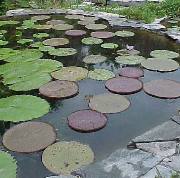 |
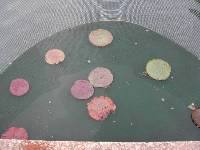 <Victorias in Florida May and ^ in Washington D.C. June |
Goal
The goal in 2003 was to grow and evaluate both Victoria primary hybrids from domestic and first generation wild lines, along with displaying both species and also Euryale ferox. Plants to be supplied by Kit Knotts. Various factors led to this goal not being entirely achieved.
Data taken: Growth development, fertilization, water temperature, and pictures were taken approximately every other week.
V. 'Adventure' & 'Longwood Hybrid' | V. cruziana & V. 'Columbia' | V. amazonica
Effects of Hurricane Isabel | Season's End
June Weather and Other Miscues
The weather along the mid-Atlantic Coast, including Washington D.C., was somewhat atypical in relation to cooler than normal temperatures and higher than normal rainfall. Although both these factors played a important role in our difficulty getting our plants transplanted and growing in the aquatic pool, the most significant factor was the lack of sunlight, especially in June, due to the daily continuous cloud cover (usually accompanied by rain). Overall, sunny days (even partial) accounted for less than 25% of the days that month.
As a result, we put our initial Victorias out too early
(June 11, about a week later than our typical plant date), and
before they were well 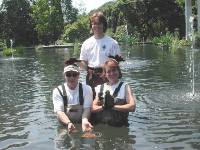 enough established. Transplant
acclimation was a serious issue and we were not prepared (time,
resources, and prior experience) to deal with it. We initially
planted out 2 'Longwood Hybrid', one from cultivated, one from
wild, parents, 1 domestic line 'Adventure', and 2 Euryale
ferox. Only the wild line 'Longwood Hybrid' survived, the
other 4 plants died by the end of June. (This was when I learned
from Kit that a Victoria without leaves is a dead Victoria).
The other 4 plants grown that year, including a 'Columbia', were
received from Kit later and were put in the pool on 6/27 and
7/17, along with our remaining E. ferox.
enough established. Transplant
acclimation was a serious issue and we were not prepared (time,
resources, and prior experience) to deal with it. We initially
planted out 2 'Longwood Hybrid', one from cultivated, one from
wild, parents, 1 domestic line 'Adventure', and 2 Euryale
ferox. Only the wild line 'Longwood Hybrid' survived, the
other 4 plants died by the end of June. (This was when I learned
from Kit that a Victoria without leaves is a dead Victoria).
The other 4 plants grown that year, including a 'Columbia', were
received from Kit later and were put in the pool on 6/27 and
7/17, along with our remaining E. ferox.
Koi Frenzy
 The
primary goal in relation to the collection management of the
Arboretum's aquatic pool has been the seasonal display of a diverse
group of aquatic plants and also to maintain a permanent population
of Japanese koi. Although presenting specific additional challenges,
such as plant damage and fertilization protocol, we have been
successfully able to do this. The only significant negative effect
we usually observe is some early season damage to the hardy aquatics
due to koi spawning. Primary koi spawning periods usually are
finished by early May.
The
primary goal in relation to the collection management of the
Arboretum's aquatic pool has been the seasonal display of a diverse
group of aquatic plants and also to maintain a permanent population
of Japanese koi. Although presenting specific additional challenges,
such as plant damage and fertilization protocol, we have been
successfully able to do this. The only significant negative effect
we usually observe is some early season damage to the hardy aquatics
due to koi spawning. Primary koi spawning periods usually are
finished by early May.
In 2003 however, our koi were indeed frenzied. Major spawning
episodes were delayed and continued through the month of June.
This was likely caused by the weather and possibly by our increasing
koi population (normal koi cull schedule is once every 3 years).
Regardless, the damage caused by the koi on our tropical aquatics
was devastating, especially on our water lilies, below left.
The koi also "decided" to pay close attention to our
Victoria transplants - behavior we had never seen before.
As a result, all our Victoria transplants had to be either
individual caged or initially put in an area of the pool protected
from the koi, below right.
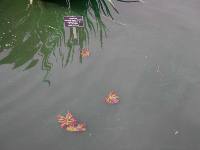
|
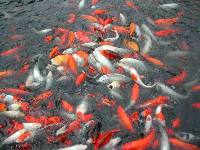
|

|
Observations and Summary
Growth: Overall, our Victorias' growth progress was about a month behind what we normally observed, primarily due to the weather, the fish, and the acclimation issues we were faced with. The 2003 weather was unexpected, but as Kit indicated, the effect of the weather and how we dealt with it is interesting in itself, and we learn by it.
Fertilization: Actually, another goal we had for 2003 was to increase the early growth rate of our plants by combining our usual fertilizer, Pondtabbs, with the "cocktail" of biostimulants and fish emulsion Kit developed and uses in her growth experiments. We used it more in response to our growing conditions to assist in getting our small plants established. (We actually observed the benefit of using the cocktail the most in nursing our tropical water lilies back to health by applying 10ccs twice during mid June to mid July.) It is difficult to access the effect of our Victoria fertilizer protocol of fewer Pondtabbs and cocktail due to the weather conditions. In addition, we can not quantify the effect of nitrate supplied by our koi via the nitrogen cycle. Overall, based on information on the Victoria-Adventure web site, I think Pondtabbs Plus (with Seamate, and available in 2004) would be an interesting fertilizer to try.
Primary hybrids from species grown with wild collected seed:
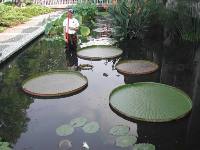 Both
'Longwood Hybrid' and 'Adventure' exhibited the trait of increased
vigor, especially the former. Also, LH 03L57 was the only plant
we placed in the pool on June 11 which survived. Further evaluation
is needed and should prove interesting.
Both
'Longwood Hybrid' and 'Adventure' exhibited the trait of increased
vigor, especially the former. Also, LH 03L57 was the only plant
we placed in the pool on June 11 which survived. Further evaluation
is needed and should prove interesting.
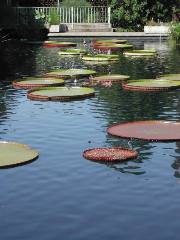 It
was my observation that the rims of both plants never displayed
the deep color of domestic line plants we've grown in the past.
Indeed, the less mature domestic 'Longwood Hybrid' we grew this
year exhibited a noticeably more vibrant color on the outer rim.
(The picture of four plants at the right includes a domestic
'Longwood Hybrid' at the far end and a wild 'Adventure' second
from foreground.) This observation could be considered significant
in relation to ornamental value. Of course, a single year of
evaluation is inconclusive at best. I discussed this with Kit
who observed unusually deep colors with her wild plants in high
light, but paler than usual color in lower light. We speculated
that lack of abundant sunlight was the cause of this on the arboretum's
plants as well, but did not rule out the possible factor of the
genotype of the seed parents.
It
was my observation that the rims of both plants never displayed
the deep color of domestic line plants we've grown in the past.
Indeed, the less mature domestic 'Longwood Hybrid' we grew this
year exhibited a noticeably more vibrant color on the outer rim.
(The picture of four plants at the right includes a domestic
'Longwood Hybrid' at the far end and a wild 'Adventure' second
from foreground.) This observation could be considered significant
in relation to ornamental value. Of course, a single year of
evaluation is inconclusive at best. I discussed this with Kit
who observed unusually deep colors with her wild plants in high
light, but paler than usual color in lower light. We speculated
that lack of abundant sunlight was the cause of this on the arboretum's
plants as well, but did not rule out the possible factor of the
genotype of the seed parents.
Final: As also indicated in my 2002 observations, my two favorite Victorias for the Washington, D.C. area in relation to performance and ornamental impact are 'Longwood Hybrid' and V. cruziana.
End Notes:
 I
left the U.S. National Arboretum after 12 1/2 years in the fall
of 2003 to spend more time with my family and to pursue other
opportunities.
I
left the U.S. National Arboretum after 12 1/2 years in the fall
of 2003 to spend more time with my family and to pursue other
opportunities.
I would like to thank my assistant Beth Finney and volunteer Cathy Sullivan for their dedication and hands-on work in relation to the aquatic pool. Without their efforts, none of the above could have been accomplished.
V. 'Adventure' & 'Longwood Hybrid' | V. cruziana & V. 'Columbia' | V. amazonica
Effects of Hurricane Isabel | Season's End
< 2002 - Full Circle: From Seed to End of Season >